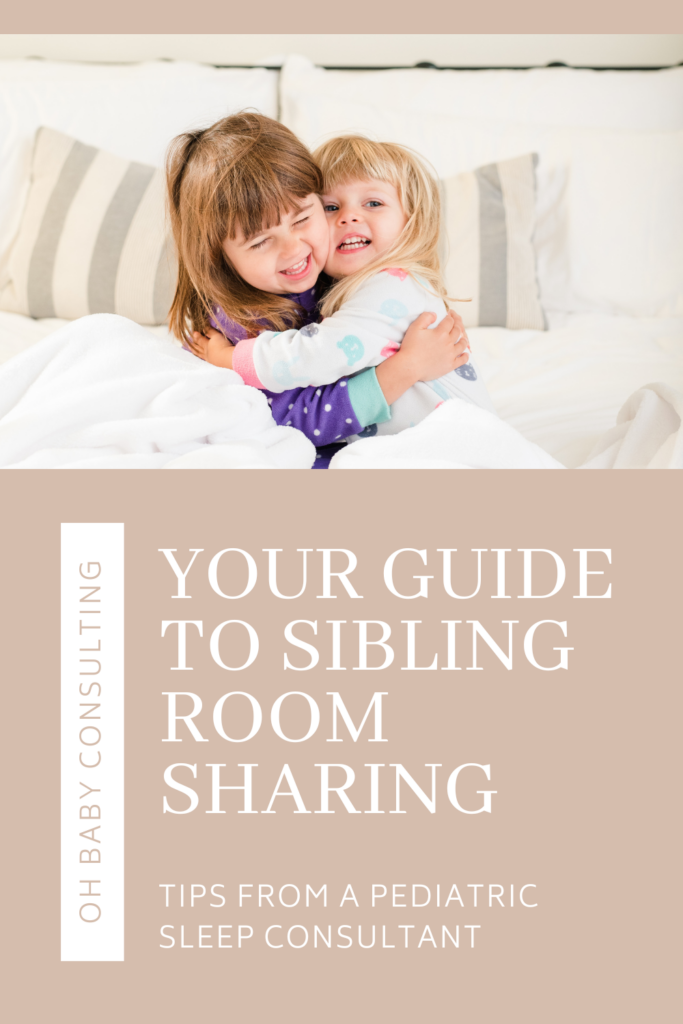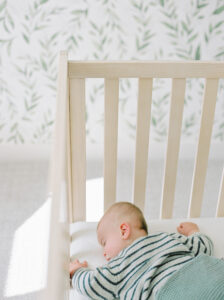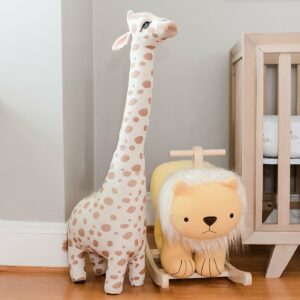If you’re planning to have your little ones share a room, it’s natural to worry about sleep getting derailed. To help you stress less and sleep more, here are my top tips for sibling room sharing.
1. Start with good sleepers
Before putting your little ones in a room together, you’ll want to make sure they each have strong sleep skills first. A young baby who is still waking up several times a night (for food or comfort) can be disruptive to an older child who is sleeping through the night. On the flip side, if you have a toddler who is getting up frequently throughout the night or is calling for you before the sun, you’ll want to tackle that before moving in a sleep-trained baby.
If you’re currently room-sharing with a newborn and thinking about when to transition them in with their big sib, I’d recommend sleep training the baby in your room and then moving them in once they’re sleeping more soundly. Of course, if your toddler or preschooler is struggling to sleep independently through the night, Toddler Sleep Coaching can make sure the whole family is sleeping peacefully prior to bunking up.
2. Be strategic with room set up
Once you’ve decided to make the transition, you’ll need to get the room set up to help promote sleep and minimize disruptions. If possible, it is best to separate cribs/beds by putting them on opposite sides of the room. If you are still doing a night feed with a younger baby, make sure to put their crib closest to the door so you can get in & out quickly.
Additionally, placing a sound machine in between cribs/beds will help block out normal nighttime noises that may be disruptive to the other sleeper. But if this isn’t possible, don’t stress! It’s been shown that most kids sleep through fireworks going off & sirens going by. Benign nighttime noises from one are highly unlikely to wake the other.
3. Merge bedtime routines (or separate them strategically)
Depending on schedules, bedtimes may or may not align each night. If they do, you can have a conjoined bedtime routine of bath, PJs, and books. When age-appropriate, let each child take a turn picking out a book or two so everyone is involved.
If bedtimes are not at the same time, the later sleeper may need to have most of their bedtime routine outside of the bedroom. Save quiet hugs & kisses as the only step that takes place in their sleep space.
4. Communicate clear expectations & firm boundaries when age appropriate
For older siblings who may now be sharing a room with their baby sister or brother, you may need to have some discussions leading up to move-in day. Talk about any changes to the current routines, discuss what to do if they hear their sibling in the middle of the night, and go over expectations around not waking their sibling if they’re the first one up in the morning.
If you have a toddler or younger preschooler, role playing in the days leading up to the move can be very helpful. You can also create a social story (a story you write featuring your child) explaining what to expect and how to behave when sharing a room with a sibling.
5. Be patient & consistent
Your toddler, preschooler, or older child may have some strong feelings about sharing their space, and depending on their age and emotional maturity, they may not have the verbal skills to communicate their feelings. This may result in some behavior changes, big emotions, or even sleep disruptions.
To make the transition fun, involve your older child in room-set up and prep. Have them create a welcome sign for their little sibling. You can also buy a “room-warming” gift from little sib to give to big sib on the morning of move-in day to keep the peace between everyone.
If you’re noticing push-back or defiant behavior in response to this transition from your older child, adding in 10-15 minutes of intentional 1:1 time during the day can be enormously impactful in filling their cup. Understand that this is an adjustment for them and keep lines of communication open. If overnight sleep gets rocky, build in big praise & rewards each morning for great nights of sleep.
If you’re struggling to prepare for or execute this transition, you don’t have to do it alone! Whether you’d like help teaching your little ones sleep independence pre-move or troubleshooting any slipping sleep skills post-move, I’m here for you!














